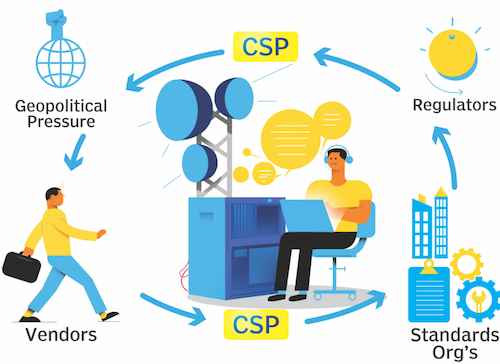Software-Driven Ecosystems
The result for CSPs are fragile networks that are expensive to operate. Large legacy vendors have tried to repackage existing product lines with new names. Both are ripe for disruption. New entrants such as the airborne and LEO (Low Earth Orbiting Satellite) initiatives are setting out to do this. Amazon, Google and Facebook stand in the wings. Rakuten is deploying a software-driven network in Japan. Yet others may still be in stealth mode.
Although China hasn’t gone on the same path, it has achieved much the same result as it maintains government control through subsidization. This arrangement, in addition to its handling of intellectual property, has essentially brought it to the same point. A detailed discussion of this will be covered in a follow-on article.

Figure 1 - Feedback Loop Reinforcing Mechanistic Paradigm
The Management Dilemma
Because of the way the business has evolved, telecommunications industry senior management has come to be dominated by people with backgrounds in law, finance, and marketing, with good political skills. These people tend to pick ‘their tech guy’ to whom they look for help when they feel they need it. The problem has been that this tech guy has often been focused on building an internal empire around a single tech initiative and so tends to develop a problematic outlook. This problematic outlook can be characterized by an overconfidence in his own technical competence and a syndrome we’ll call Not Invented Here (NIH). Until the advent of softwarization, this was not great but not disastrous. Now, it is a real stumbling block.
These internal tech guys do not have the necessary expertise to make the needed transition to softwarization. Even worse, they risk blocking themselves and others from learning. An example may help to illustrate. One such tech guy, in a recent conversation with an outside technologist, maintained that there was, and could only be, one virtualization layer in an information system. He was told that Intel processors today have an internal virtualization layer that exposes an X86 instruction set externally and uses a different architecture internally, and that there are many virtualization layers above that. He was so confident in his view that he rejected all this real-world data.
On the other hand, there are a few people in the industry who have been trying to act as thought leaders in this area. Until recently, they have been ‘voices in the wilderness.’ Many have ignored them. A few have recognized that these people have been pointing at a real problem, but they felt that the problem was too big to tackle. Recently, some of these people have begun to find each other and started to try to find ways of reinforcing each other.



















